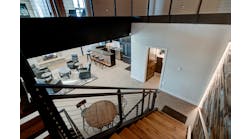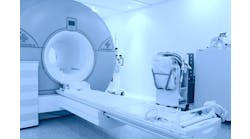Minnesota Transforms Historic Railway Depot into Modern Transit Hub
The last train left St. Paul, Minn.’s Union Depot in 1971, and its historic Waiting Room went dark. The windows and skylights were boarded up, the roof was leaking, and pigeons made their home in the dilapidated, vacant structure. Nearly 40 years later, the 1920s-era railroad depot has been brought back to life as a modern multi-modal transit facility. Originally built in 1923, the facility underwent a $243-million renovation that transformed the historic structures and 33-acre site into a hub for light rail, commuter rail, high-speed rail, intercity and regional buses, and bicycles.
The initial project study began in 2001 with construction starting in January 2010 and wrapping up in October 2012. Through years of hard work and careful planning, the Ramsey County Regional Railroad Authority and its team of contractors were able to not only meet historical preservation guidelines and the Section 106 Review process, but also pursue a LEED Gold designation from the U.S. Green Building Council.
In its heyday, the Union Depot had 300 trains and 20,000 passengers come through it every day. Now that the area has been revitalized, a new level of activity has taken off, says Michael Bjornberg, project manager and historic architect of HGA Architects and Engineers of Minneapolis.
“When you restore 33 acres in a downtown area, it’s incredible to see what it does to the vitality of a city,” Bjornberg says. “This area is really starting to come back.”
Preserving the structure’s history
The Union Depot was placed on the National Register of Historic Places in 1974. As such, the electricians and other workers had to follow the guidelines of the Secretary of the Interior Standards, the State Historical Preservation Office, and Saint Paul Heritage Preservation Commission while meeting the needs of a modern transit facility.
Hunt Electric, the electrical contractor on the project, worked alongside Mortensen Construction, the general contractor; URS Corp., the site and rail engineers; and HGA Engineers and Architects, the engineering and design firm. The historical renovation project consisted of three main parts: the Waiting Room, which spans the length of a football field; the Front Plaza; and the Head House, which features condos, offices, and a restaurant. To restore the 90-yr-old, 48,000-sq-ft building back to its original grandeur, the firms had to rely on the original construction drawings and extremely limited as-built drawings.
“When you work with a historic building, you find out very quickly that a turn-of-the-century drawing doesn’t refer to the current conditions, especially if there have been modifications along the way,” Bjornberg says.
While working on the site, the electricians had to find conduit routing and pathways through the existing building without jeopardizing the finishes, says Chris Herman, project manager for Hunt Electric of St. Paul, Minn. The concrete structure, slabs, and walls were all very thick, which produced a unique set of challenges.
In some cases on the interior, the electricians, masons, architects, and engineers also had to work hand-in-hand to remove existing historic brick in order to route electrical conduit for lighting. The masons then re-laid the brick in a manner that left no visible trace of intervention.
The team also laser scanned the attic spaces as well as the volume of the building and then input this data into a BIM model. Through this scan, the workers discovered asbestos in the attic space. Once this problem was abated, the workers installed the raceways in the beam pockets and interstitial space.
Above the 27,000-sq-ft waiting room, the long, narrow spaces also became a suitable avenue for accessing power and communications wiring. To reach the 40-ft arched ceiling, the electricians used scaffolding and lifts — outfitted with proper fall protection. In this space, the crews also installed duct work.
With such a large project and so many trades on site, safety became paramount. The companies had a plan-of-the-day meeting led by Mortensen Construction to discuss what areas they would be working in as well as what they would be doing on a particular work day. Overall, the workers put in 40,000 field labor hours, and at the peak of the project, 65 electricians were on site.
“It was a very fast-paced project, and we were under the spotlight to move fast and make it happen,” says Bjornberg.
Illuminating the historic rail depot
During the historic renovation, the electricians not only brought the building back up to code with new wiring and electrical equipment, but they also installed new luminaires.
“It’s amazing how buildings are wired now compared to how they used to be,” Bjornberg says. “In the past, they had an outlet on each wall, and they used them for maintenance. They also relied a lot more on daylighting, and the buildings were very dark. We view lighting a lot differently today.”
Today, lighting designers can perform a lighting analysis in a building long before a crew ever shows on the job. Through this software, they can achieve even lighting levels throughout a structure by placing fixtures at the proper height and using the right amount of footcandles.
As a result of this software program, they were able to determine how many fixtures were needed and where they should be installed. The construction team was able to reuse some of the historic lighting fixtures. In addition, the firm was able to modernize the historic fixtures hanging in the Head House with more energy-efficient luminaires. The electricians also installed extensive dimming and lighting control systems, daylight photocells, occupancy sensors, and fluorescent and LED luminaires to replace the old incandescent ones.
Trying to figure out how to illuminate the outside of this building, however, proved quite a challenge. The construction team had photos of the building’s exterior, but not any close-up images of the old fixtures. For that reason, they studied the effect of the lighting in the photos, and then tried to recreate it with new luminaires.
Preparing for the future
After a few years of renovation, the Union Depot is now ready to serve as a hub for local, state, and regional transportation. To meet modern needs, the building is outfitted with terminals with interactive displays and access to the Internet. Electricians also installed conduit and floor boxes in the waiting room so that visitors can plug in their cell phones or computers while they’re waiting for a bus or train to arrive.
“At airports, you can plug in almost anywhere, and the same is expected of other transportation buildings,” Bjornberg says.
The team also rebuilt the train deck, tracks, and a new multi-level passenger drop-off entrance, complete with ticket and baggage counters. Train service is scheduled to begin this fall, and the Central Corridor Light Rail is slated to start service next year. Jefferson Regional Bus Lines and Metro Transit, the city bus transit systems, are already in operation and making stops at the Union Depot.
“This successful, elaborate renovation of Union Depot is a direct result of the efforts and hard work put forth by the entire construction team,” Herman says. “Once all the transportation services are fully operational, it will no doubt become a vibrant hub once again.”
Fischbach is a freelance writer based in Overland Park, Kan. She can be reached at [email protected].




